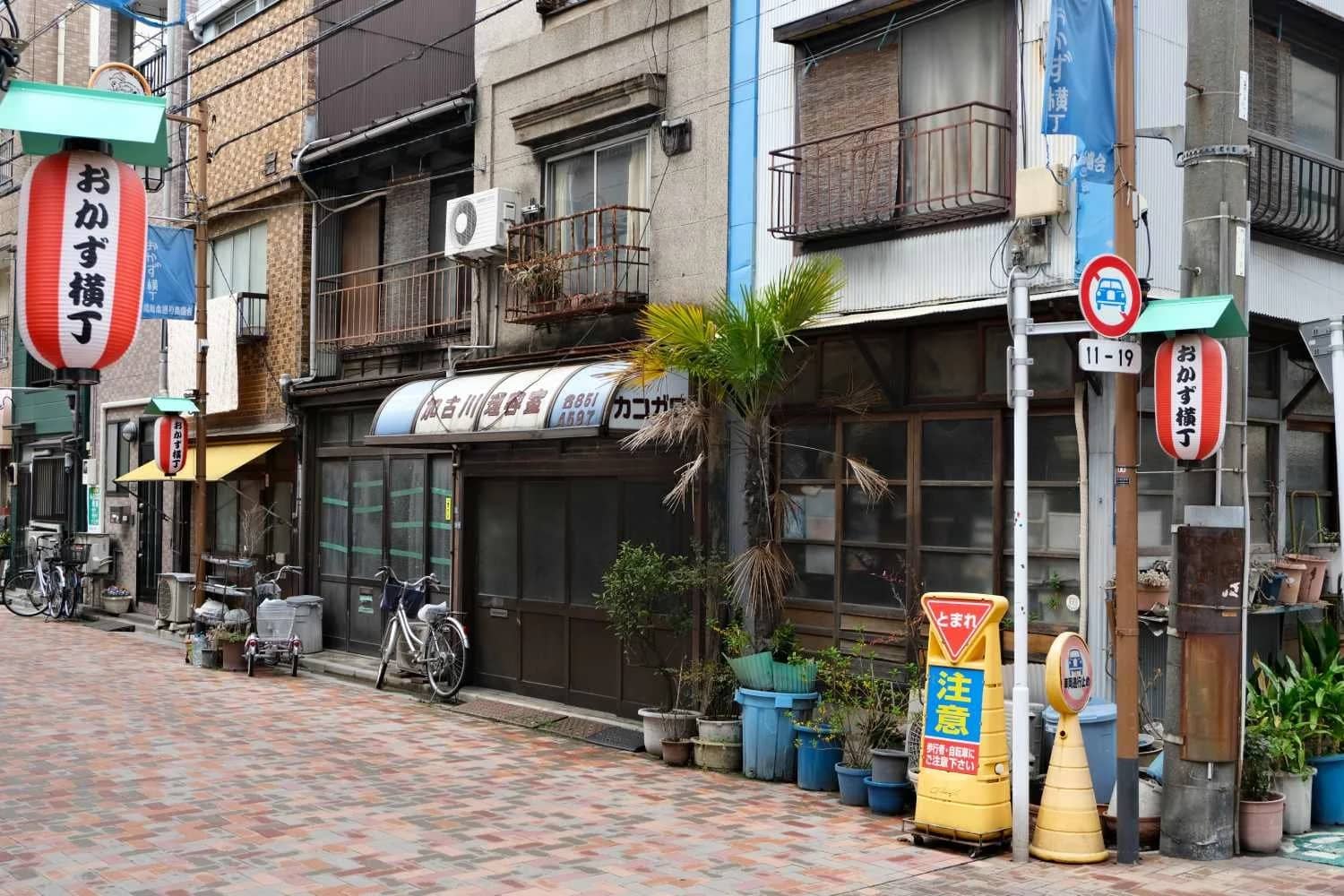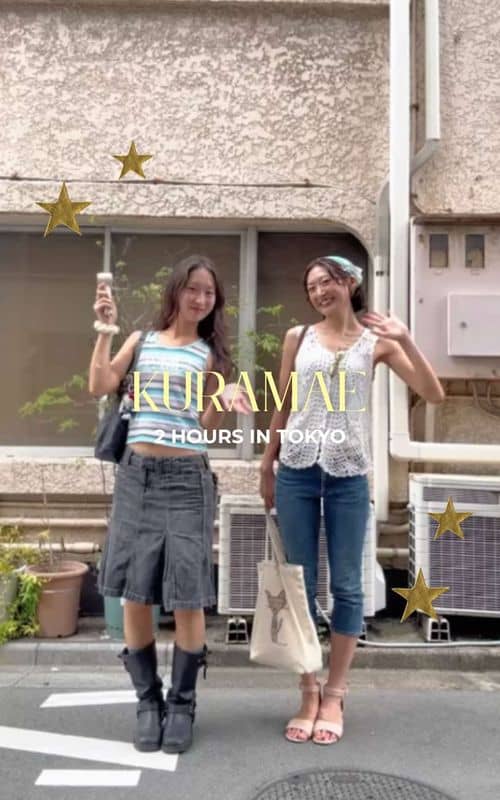Kuramae Tokyo
Kuramae: Tokyo's artisan heart, blending traditional crafts with a hip, modern vibe. Discover unique boutiques, cafes, and a relaxed atmosphere.

Highlights
Must-see attractions

Social
From TikTok & Reddit
Best Time
Fewer crowds, relaxed vibe
Kuramae Tokyo
Best Time
Fewer crowds, relaxed vibe

Highlights
Must-see attractions
Kuramae: Tokyo's artisan heart, blending traditional crafts with a hip, modern vibe. Discover unique boutiques, cafes, and a relaxed atmosphere.
"A charming neighborhood where old-world craftsmanship meets contemporary cool."
🚶♀️ Wander and Discover
Get lost in the charming streets to find hidden gems and local crafts. :camerawithflash:
☕️ Cafe Hopping Delight
Kuramae is packed with stylish cafes perfect for a break. Try a local specialty! :coffee:
Highlights
Discover the most iconic attractions and experiences

Artisan Boutiques & Cafes
Throughout Kuramae
Discover unique handmade goods and trendy cafes in this former artisan district.

Sumida River Views
Near Kuramae Station
Enjoy scenic riverside walks with views of Tokyo Skytree and passing boats.

Traditional Craftsmanship
Various workshops
Experience the legacy of Kuramae's hat, shoe, and leather goods makers.
Plans like a pro.
Thinks like you
Planning Your Visit
Embrace the Artisan Spirit
Strategic Location for Exploration
Best Times
Insider Tips
from TikTok, Instagram & Reddit
🚶♀️ Wander and Discover
Get lost in the charming streets to find hidden gems and local crafts. :camerawithflash:
☕️ Cafe Hopping Delight
Kuramae is packed with stylish cafes perfect for a break. Try a local specialty! :coffee:
🧳 Pack Light for Travel
Easy access to trains makes exploring Tokyo a breeze. :train2:
🛍️ Support Local Artisans
Many shops offer unique, handmade items. Great for souvenirs! :gift:
Tips
from all over the internet
🚶♀️ Wander and Discover
Get lost in the charming streets to find hidden gems and local crafts. :camerawithflash:
☕️ Cafe Hopping Delight
Kuramae is packed with stylish cafes perfect for a break. Try a local specialty! :coffee:
🧳 Pack Light for Travel
Easy access to trains makes exploring Tokyo a breeze. :train2:
🛍️ Support Local Artisans
Many shops offer unique, handmade items. Great for souvenirs! :gift:
What Travellers Say
Reviews Summary
Visitors praise Kuramae for its unique blend of traditional artisan heritage and modern, trendy cafes and boutiques. Its convenient location and relaxed atmosphere make it a delightful base for exploring Tokyo, though some note that it can get busy on weekends.
What People Like
What People Dislike
Frequently Asked Questions
🚇 🗺️ Getting There
For an early morning arrival at Narita (NRT), the most efficient way to reach Kuramae is by taking the Keisei Skyliner to Ueno Station, then transferring to the Tokyo Metro Ginza Line to Kuramae Station. This route is generally faster than the Narita Express for reaching this part of Tokyo. Alternatively, the JR Narita Line to Nippori Station and then a transfer to the JR Yamanote Line to Ueno, followed by the Ginza Line, is another option. Taxis are available but will be significantly more expensive.
Kuramae is exceptionally well-connected. It's served by the Toei Asakusa Line and Toei Oedo Line, offering direct access to major hubs like Shinjuku, Shibuya, and Ginza. The nearby Tokyo Metro Ginza Line also provides convenient access to areas like Asakusa and Ueno.
Yes, the Toei Asakusa Line from Kuramae Station offers direct connections to Asakusa, Nihonbashi, Ginza, and even Haneda Airport. The Toei Oedo Line provides direct access to Shinjuku and Roppongi.
Absolutely! Kuramae is a very walkable area, perfect for exploring its many independent shops, cafes, and galleries on foot. The streets are generally flat and pleasant for strolling.
The primary stations serving Kuramae are Kuramae Station (Toei Asakusa Line and Toei Oedo Line) and the nearby JR Ryogoku Station (JR Chuo-Sobu Line and JR Sobu Main Line), which is about a 10-15 minute walk away.
🎫 🎫 Tickets & Entry
Most attractions in Kuramae are independent shops, cafes, and galleries, which typically do not require advance booking. However, for specific workshops or special events, it's always best to check their individual websites.
Shop hours can vary, but generally, most boutiques and cafes in Kuramae open around 10 or 11 AM and close between 6 and 8 PM. Some may have shorter hours on weekdays or be closed on certain days, so it's advisable to check ahead if you have a specific place in mind.
Exploring the streets and general atmosphere of Kuramae is free. Entrance fees would only apply if you choose to enter specific museums, galleries, or participate in paid workshops.
Yes, Kuramae offers a range of accommodation options, including hostels and budget-friendly hotels like Toyoko Inn and APA Hotel, making it a good choice for budget-conscious travelers.
While many smaller shops and cafes may prefer cash, major hotels and larger establishments accept credit cards. It's always a good idea to carry some Japanese Yen for smaller purchases and local markets.
📸 📸 Photography
Look for charming street scenes with unique shop fronts, the Sumida River with views of Tokyo Skytree, and the intricate details of traditional crafts. The area around Kuramae Station itself offers interesting architectural contrasts.
Generally, it's polite to ask permission before taking photos inside shops, especially if they are small or display delicate items. Many shop owners are happy to have their creations shared, but a quick 'shashin ii desu ka?' (Is photography okay?) goes a long way.
Golden hour, just after sunrise or before sunset, offers beautiful soft light for capturing the neighborhood's atmosphere. Midday can be harsh, but it's great for capturing the vibrant colors of the shops.
The Sumida River offers iconic shots with Tokyo Skytree in the background. Also, keep an eye out for the unique signage and architectural details of the independent boutiques that define Kuramae's aesthetic.
Kuramae is perfect for street photography, capturing the blend of old and new, and showcasing artisanal products. It's also great for lifestyle and architectural photography.
🍽️ ☕️ Food & Dining
Kuramae boasts a diverse culinary scene, from traditional Japanese fare like ramen and tempura to trendy cafes serving specialty coffee, pastries, and light meals. You'll also find international options.
Many visitors rave about the coffee culture in Kuramae. Look for independent roasters and cafes that offer unique brewing methods and delicious baked goods.
For dinner, explore options ranging from casual izakayas (Japanese pubs) to more refined dining experiences. Many restaurants focus on fresh, seasonal ingredients.
While traditional Japanese cuisine can be meat-heavy, many modern cafes and restaurants in Kuramae are increasingly offering vegetarian and vegan-friendly options. It's always best to inquire directly.
You can find a wide range of prices, from affordable ramen shops and cafes (¥1,000-¥2,000) to mid-range restaurants (¥3,000-¥5,000) and higher-end dining experiences.
For Different Travelers
Tailored advice for your travel style
👨👩👧 Families with Kids
While Kuramae isn't packed with dedicated children's attractions, its charm lies in its discoverability. Encourage kids to spot unique shop signs or look for the artisan crafts. The proximity to Asakusa means you can easily combine a visit to Kuramae with the more traditional sights like Senso-ji Temple, offering a varied experience for all ages.
🚶♀️ Solo Travelers
Consider staying in one of the area's hostels or budget-friendly hotels for a social atmosphere and to keep costs down. The neighborhood's walkability and the friendly nature of many shop owners make it easy to strike up conversations and get local recommendations.
🛍️ Shoppers & Art Enthusiasts
Beyond shopping, Kuramae has a growing number of galleries and design studios. Keep an eye out for pop-up exhibitions or workshops that showcase contemporary art and design. The area’s transformation from a traditional craft district to a modern creative hub makes it a fascinating place for anyone interested in design and craftsmanship.
Deep Dives
In-depth insights and expert knowledge
The Artisan Legacy of Kuramae
This blend of old and new is what makes Kuramae so captivating. You'll find independent boutiques selling handmade accessories, artisanal bakeries, and stylish cafes that have taken over former workshops. It's a place where you can appreciate the meticulous craftsmanship of the past while enjoying the contemporary creativity of the present. Exploring these streets feels like uncovering hidden treasures, with each corner offering a new discovery.
When visiting, take the time to seek out shops that still practice traditional crafts or sell items made with a similar dedication to quality. This is where the true essence of Kuramae lies, offering a more authentic and meaningful souvenir than mass-produced items. It’s a testament to the enduring appeal of handmade goods in a fast-paced world.
Navigating Kuramae's Transport Hub
The Toei Oedo Line from Kuramae offers direct routes to major hubs such as Shinjuku, Roppongi, and Ikebukuro, allowing for seamless exploration of different facets of Tokyo. For those arriving from Narita Airport (NRT), taking the Keisei Skyliner to Ueno Station and then transferring to the Tokyo Metro Ginza Line to Kuramae is a recommended and efficient route, especially for early morning arrivals.
Beyond the subway, the Sumida River runs alongside Kuramae, offering scenic ferry services that connect to other riverside attractions like Odaiba and Hamarikyu Gardens. While not as frequent as the subway, a river cruise can be a delightful way to see the city from a different perspective. The walkability of Kuramae also means that many attractions, including the Tokyo Skytree and Senso-ji Temple in Asakusa, are within reasonable walking distance or a short transit ride away.



Social
from TikTok, Instagram & Reddit